What are the Basic Electrical Formulas?
To understand electricity, the basic formulas shown below are essential.
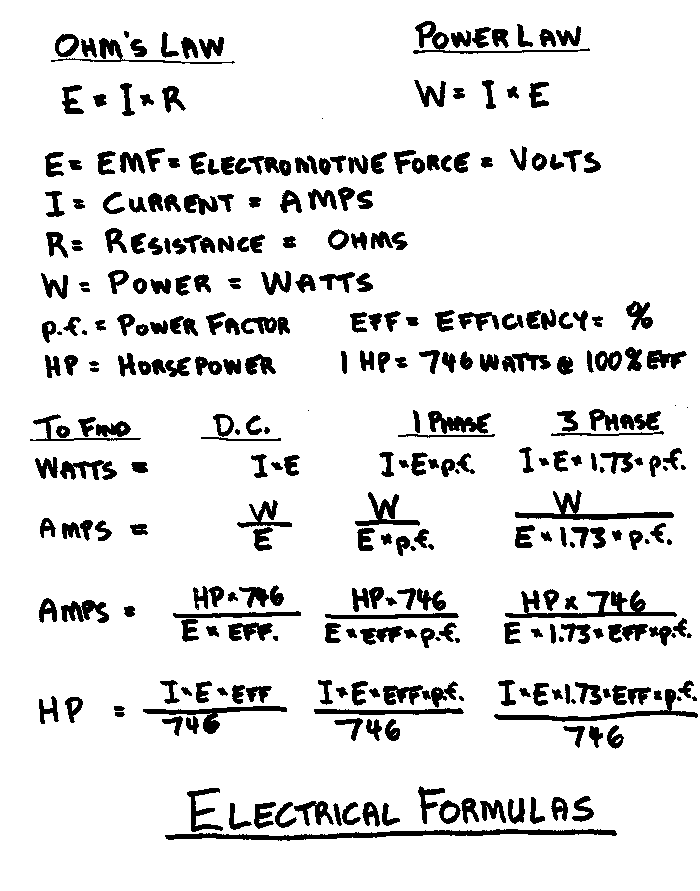
If you'd rather look at some electric formulas developed from the US military. Here's another set:
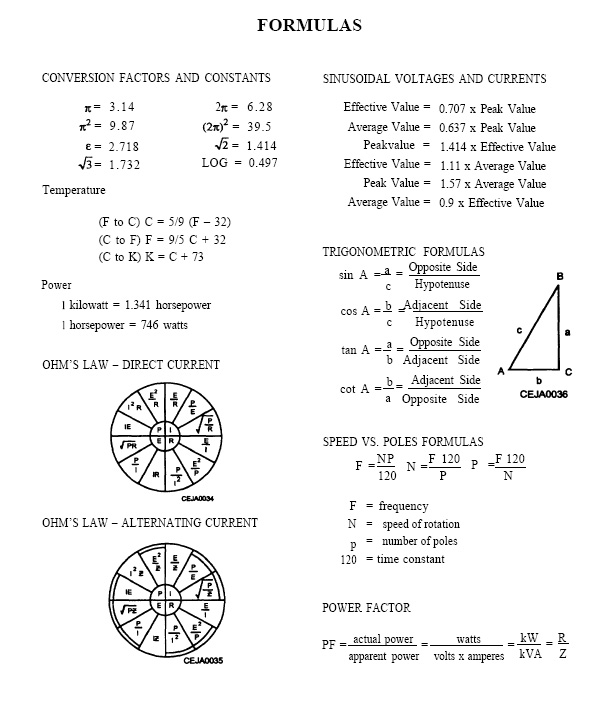
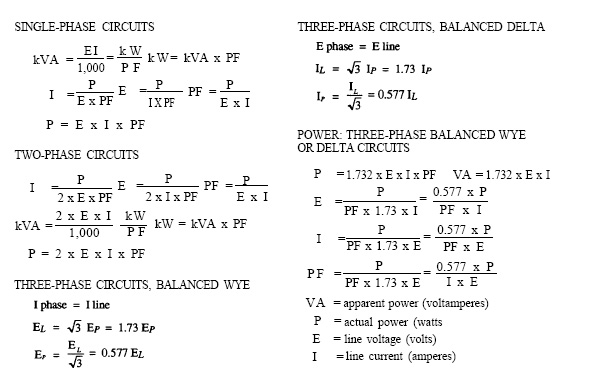
What is the Difference between DC and AC?
DC stands for Direct Current. A circuit powered by a battery is a DC circuit. Most electronic devices run on DC. Continuing with the analogy of water in a hose, a DC circuit has all the water flow in one direction. The reason why all electrical power isn't DC, though, is because it can't be easily transmitted long distances or changed into other voltages. So the early days of electrical power used DC, but required large diameter wiring (expensive) and local power generators (impractical).
Therefore, a more efficient type of electrical power developed...Alternating Current. When thinking about AC, the analogy of the water hose no longer works well. In AC, the current flow reverses direction in a circuit, flowing first in one direction, then in the other. This reversal of flow takes place 60 times in one second for typical electrical AC power in America. Thus the AC power is called 60 cycle (or 60 Hertz). The normal AC power in much of the rest of the world is 50 cycle. The number of cycles is chosen as a mostly arbitrary standard. The map shown in this Wikipedia link http://en.wikipedia.org/wiki/Utility_frequency illustrates the standard voltages and frequencies most countries in the world chose.
As an aside, lights and motors tend to be designed to work at either 50 cycles or 60 cycles. The wrong frequency in lights causes a flicker and in motors more serious problems can occur. Understand that electrical appliances typically are designed for 60 cycle or 50 cycle power and will have problems with efficiency, or even safety, if the correct frequency isn't used.
AC power became the standard throughout the world, mostly because transformers allow AC power to change voltages. So Utility Companies can produce electricity and send it over high voltage lines (say 11,000 volts), then simply transform the power to 120 volts for normal use. This ability to send high voltage power over transmission lines allows more power to be sent over smaller diameter cable, and with less transmission loss, than DC power would allow.
How is Single Phase AC Different from Three Phase AC?
To begin with the simple, practical information, single phase AC power requires 3 wires: a hot, a neutral and a ground. Three phase requires 5 wires: 3 hots, a neutral and a ground. In three phase, each of the hot wires can complete a circuit with the neutral. Three phase power can carry more electrical capacity than single phase. Starting a 10 hp motor (starting a motor can require 6 times more power than running a motor) may cause a single phase line to blink or have a low voltage. A three phase line could allow that 10 hp motor to start without problem. Generally, three phase motors are more compact and efficient than similarly sized single phased motors, so the use of three phase motors is widespread. Large motors get used in so many applications: elevators, fans, blowers, compressors, pumps, conveyor drives, etc., so many projects require three phase electrical power.
To understand three phase power, think about the 60 cycles of alternating current electricity, discussed above. Each 1/60th of a second has a directional shift in the current. The current flows in one direction, then back in the other direction. The 3 Phase Electrical Wave figure below illustrates the black line (phase #1) flowing in one direction at 0, then flowing in the other direction at 180 and finally flowing back in the original direction at 360. The red line (phase #2) and the blue line (phase #3) start off the directional shifts at different times. This phase separation must be considered to get the correct phase rotation when wiring induction motors. In other words, one hook-up makes the motor run forward, the other hook-up makes it run backwards.
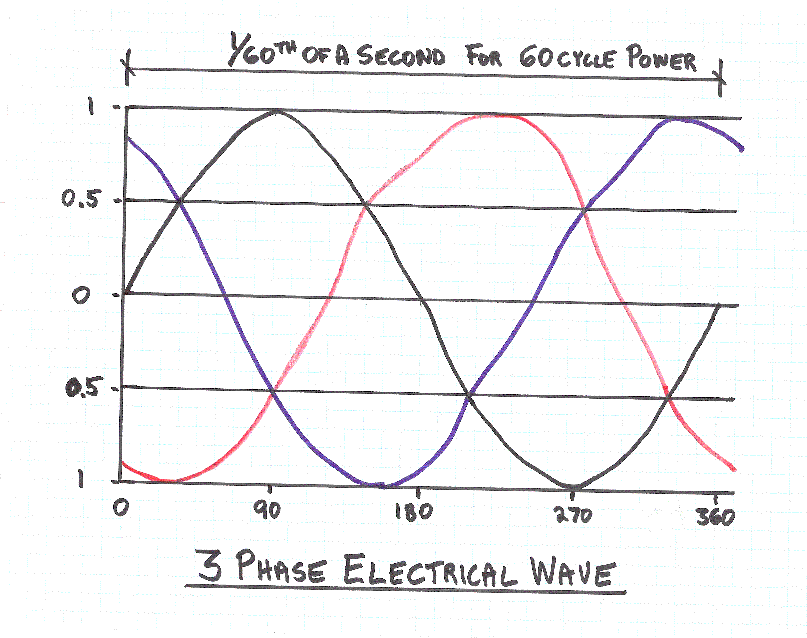
So the three phase electrical system has 3 conductors carrying voltage waveforms (shown above) that are offset in time by 120 degrees or 1/3 of a cycle.
When designing three phase electrical systems, one strives to balance the load between phases. In a 5 wire, 120/208 volt system, two of the hots create a 208 volt circuit while a hot and a neutral create a 120 volt circuit. One tries to balance the load (current), voltage and impedance on each of the phases. Of course a perfect balancing never happens. But too much of an imbalance causes higher operating temperature, shorter motor life and less efficiency.
What is the Difference between KW and KVA?
Electrical utility companies provide volt-amperes to customers, but bill them for watts. Understanding this concept will help you better understand many of the decisions made by project owners and electrical engineers. Since the Power Law shown above lists Watts = Volts x Amps, you may think that the number of volt-amperes should be the same as the number of watts. After all, that's what the Power Law equation states. And it's true when the load is resistive, say an electrical heating element that uses all the power that is delivered to it by changing the electrical energy into heat energy. A motor or a fluorescent light, on the other hand, are reactive loads in that part of the electrical power that goes to them gets absorbed, then returned to the circuit without being used. The reactive portion of the load dissipates no power.
Let's look at it a different way. When trying to understand generators that are specified for a project, you will often see them listed with KVA numbers. So what does that mean? If you know that you will have 100 amps of load at 208 volts, you'd need an transformer with at least 20.8 KVA. If you installed that transformer and measured the volts you'd see 208 volts and an amp meter would show 100 amps. But since part of that current goes back into the circuit without being used, the real power (or the KiloWatts) would be less than 20.8 KW. The figure below illustrates:
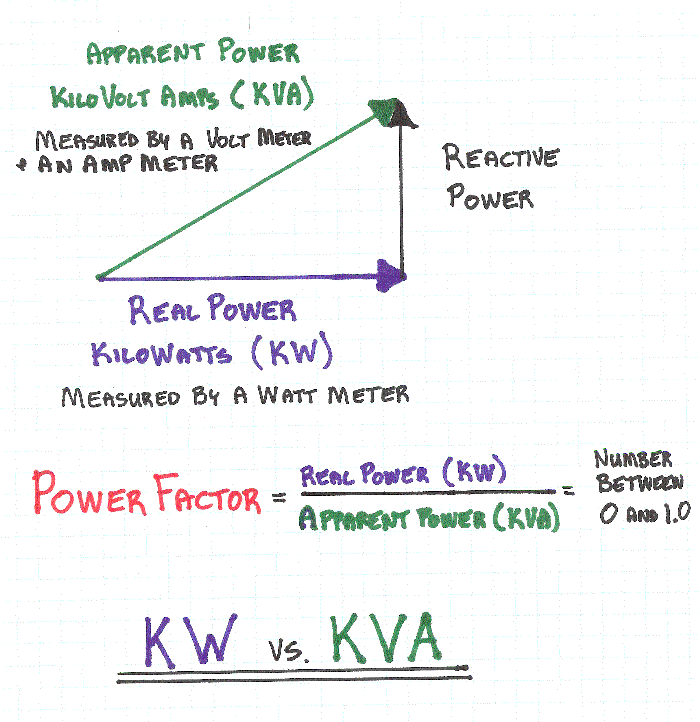
So with our generator example above, if the power factor is 0.8, then the real power used will be 20.8 KVA x 0.8 power factor or 16.6 KW.
Since we're discussing generators, it's good to know that the industry standard power factor assumed for rating generators is 0.8. But the reality of what the generator will actually drive under load depends on the actual power factor. To continue with the above example, if you use a 16.6 KW generator but lots of small induction motors are being powered and the true power factor is 0.6, then the apparent power required will be 16.6 KW / 0.6 = 27.7 KVA. The right conclusion to draw, though, is to discuss and purchase generators using the KVA requirements, not the KW.
What is the Power Factor?
The illustration above shows that the power factor is a number between 0 and 1.0 that is a ratio between the true power (KW) and the apparent power (KVA). Some typical power factors are shown below:
| Various types of loads | Power factor |
| Electric resistive heating | 1.0 |
| Incandescent lighting | 1.0 |
| Incandescent lighting with a step down transformer | 0.95 to 0.98 |
| Fluorescent lighting | 0.5 to 0.95 |
| Single phase induction motor up to 1 HP | 0.55 to 0.75 |
| Single phase induction motor 1 HP to 10 HP | 0.75 to 0.85 |
| Three phase induction motor 1 HP to 10 HP | 0.75 to 0.91 |
| Electric welding transformers | 0.50 to 0.70 |
| Synchronous motors | 0.80 to 1.0 |
As you can see, power factors can vary widely depending on the loads. So why does that matter? Power companies don't like supplying the apparent power requirements but only getting paid for the true power that's used. So an industrial plant with a low power factor has to have lots more energy supplied to it than it pays for, creating an inefficiency for the power companies. As you can imagine, power companies tend to prize efficiency, so they typically bill that industrial client with the low power factor a penalty to encourage them to improve. Under-loaded induction motors often lower a power factor, so an industrial plant may replace those motors with smaller capacity motors or going with synchronous motors.
No comments:
Post a Comment